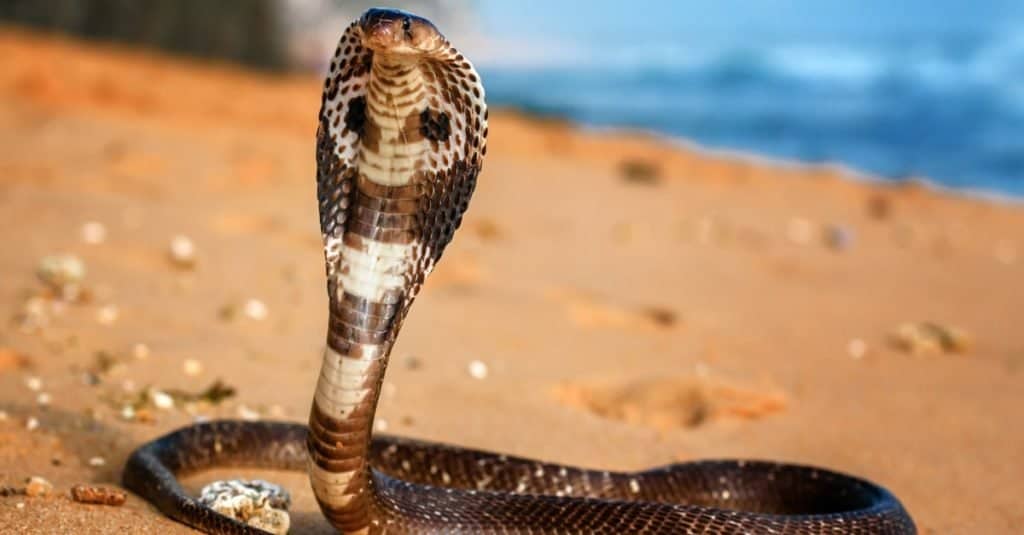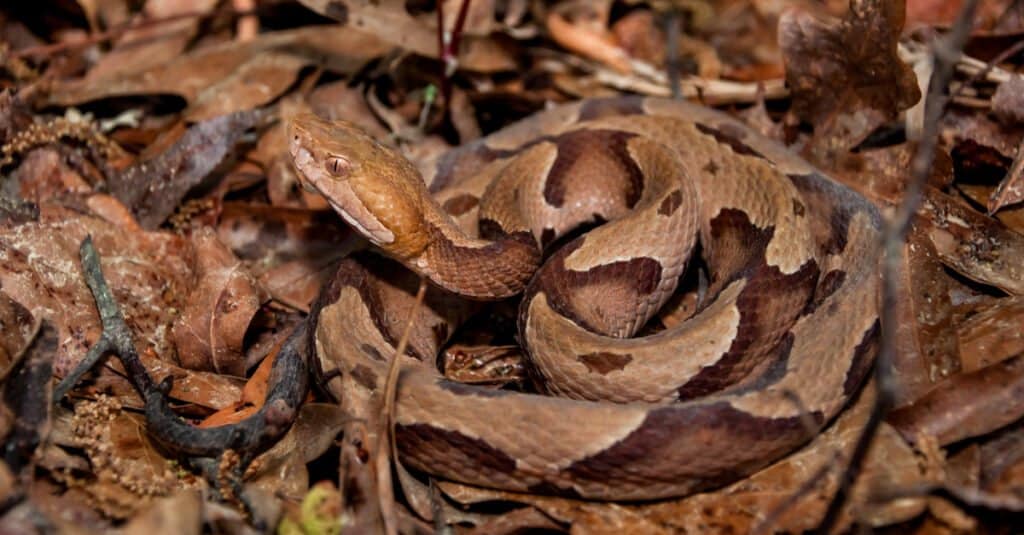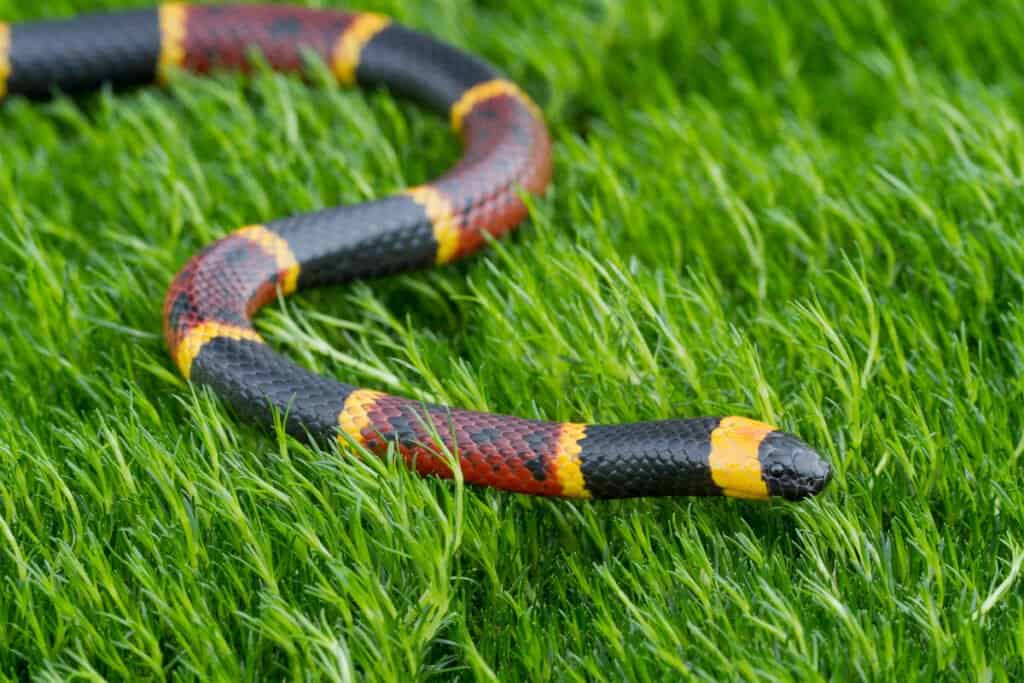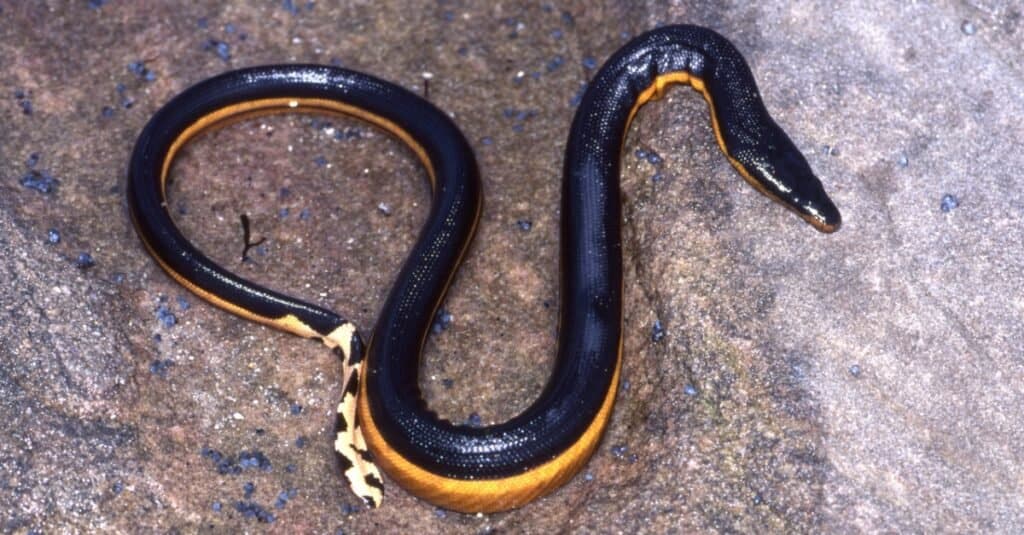Snakes are animals that strike fear into people. Their fierce looks, quirky locomotion, and threat displays are enough to make anyone feel uncomfortable. To make matters worse, we know that snakes can hide in places that you can’t see, basically in plain sight. If those facts make your skin crawl, things are about to get worse. Many snakes can swim, including venomous ones. Take a look at five poisonous snakes that can swim just as well as they can slither on the ground!
Are Snakes Venomous or Poisonous?

King cobras are highly venomous, but much of their flesh is not poisonous to humans
©Vova Shevchuk/Shutterstock.com
People often use the terms venomous and poisonous interchangeably. However, snakes are venomous or non-venomous, they are not poisonous. Specifically, venomous means that the animal can inject a substance that does damage to the body.
For example, rattlesnake venom acts as both a hemotoxin and a neurotoxin. It will kill cells in the body leading to necrosis while also impacting the function of nerves, leading to paralysis in the victim.
In the case of poisonous creatures, that can only happen if an animal were to consume another and die as a result. So, to recap, snakes are venomous, but they are not poisonous. However, the terms are used interchangeably, so we’re only splitting hairs.
What Are 5 Poisonous Snakes That Can Swim?

Cottonmouths are considered to be one of the few semi-aquatics snakes in the world.
©jo Crebbin/Shutterstock.com
The bad thing about snakes is that many of them can travel on land, in water, and climb trees. A lot of people believe that the only venomous snakes that go in the water are sea snakes, and those are limited to the Pacific and Indian Oceans.
That does not mean you won’t find venomous snakes in other waters. Venomous snakes travel to find food or seek shelter even if they aren’t completely aquatic. Those are the types of snakes that we’re going to elaborate on here.
Let’s take a look at five examples of venomous snakes that can swim but are not considered aquatic sea snakes.
1. Eastern Diamondback Rattlesnake

The eastern diamondback rattlesnake can be found miles from shore
©iStock.com/Paulo Almeida
The eastern diamondback rattlesnake is the largest venomous snake in the United States. Although this rattlesnake is widely feared for its venomous bite, many people have discovered that this snake can swim.
The eastern diamondback rattlesnake has been spotted swimming in lakes and rivers in the southeastern United States. Most surprisingly, the snake has been seen in the Florida Keys, swimming from island to island. People in boats have spotted rattlesnakes miles from the nearest land, and the snake has no problem moving well in the water.
Of course, these snakes rarely attack anyone that is in the water because the snake is simply trying to get where it needs to go and nothing more.
2. Cottonmouth (Also Called Water Moccasins)

Cottonmouth snakes have a very dramatic threat display
©Jay Ondreicka/Shutterstock.com
The cottonmouth snake is a snake that is known for spending a lot of its lifespan near water. The common name of this snake is water moccasin, but they’re the same creature. The cottonmouth snake is venomous, but it’s also subject to a lot of myths.
For example, some people believe that the snake chases people in the water, but that’s not the case. The snake will attack if threatened, but it will do what most snakes do and flee if you give it the chance. These animals got their name because of the threat display that they use when they are afraid.
They will open their mouths wide enough that you can see the white inside while hissing. Needless to say, anyone that sees this should immediately back away from the snake to avoid envenomation. These are the most common venomous snakes that you’ll find near the water in the United States.
3. Copperhead

Copperheads don’t spend a lot of time in the water but are responsible for a high percentage of venomous snake bites in America.
©Jay Ondreicka/Shutterstock.com
Copperheads are terrestrial venomous snakes that live in the eastern half of the United States. They are known for their unique copper coloring, their cat-like eyes, and the fact that they are one of the few types of venomous snakes in the U.S.
They are not known for spending a lot of time in the water. However, they can swim when the occasion arises, such as when they are caught in flooded areas. You do not want to approach these snakes when you see them in the water.
4. Coral Snake

Coral snakes can be confused for king
snakes, but these are actually far deadlier
©Mark_Kostich/Shutterstock.com
The name coral snake refers to over 50 different species. Some of these snakes spend a lot of time in the water, and some of them are mostly terrestrial. One thing is for certain, though: they are very venomous no matter where you find them.
You can find coral snakes in the United States, Asia, and many other parts of the world. Some of their species are counted among some of the deadliest snakes in the world. At least, going by the potency of their venom. Fortunately, they also have small fangs, so they are not as capable of injecting venom into their victims, including humans.
5. Eastern Brown Snake

Eastern brown snakes
will attack if provoked
©Ken Griffiths/Shutterstock.com
The brown snake can refer to both an American snake as well as an Australian variant. We’re referring to the latter. The eastern brown snake is long, fast, and highly venomous. In fact, it’s known to be one of the deadliest snakes in the entire world.
Although it doesn’t spend as much time in the water as the water moccasin, they are capable swimmers that are frequently spotted in pools and other bodies of water. These snakes are highly dangerous and might be the worst snake to run into while swimming aside from some deadly sea snakes.
Can I Identify a Poisonous Snake That Swims By Location?

The yellow-bellied sea snake is found in all tropical oceanic waters except for the Atlantic Ocean.
©Ken Griffiths/Shutterstock.com
A persistent myth made its rounds on social media which claimed that you can tell if a snake is venomous or not by whether it swims near the top of the water or in the middle or bottom. The claim is that a non-venomous snake will swim underwater, and venomous snakes will have their heads sticking out of the water.
However, there is no truth to this myth. You can find venomous snakes swimming above the water or underwater. A coral snake might swim underwater, and a garter snake could swim near the top. Sea snakes swim underwater entirely, and they’re some of the most venomous snakes on the planet!
The bottom line is that if you see any snake in the water, the best plan of action is to leave it alone or you might get hurt so you don’t accidentally run into poisonous snakes that can swim,
The photo featured at the top of this post is © Seth LaGrange/Shutterstock.com
Discover the "Monster" Snake 5X Bigger than an Anaconda
Every day A-Z Animals sends out some of the most incredible facts in the world from our free newsletter. Want to discover the 10 most beautiful snakes in the world, a "snake island" where you're never more than 3 feet from danger, or a "monster" snake 5X larger than an anaconda? Then sign up right now and you'll start receiving our daily newsletter absolutely free.
Thank you for reading! Have some feedback for us? Contact the AZ Animals editorial team.






